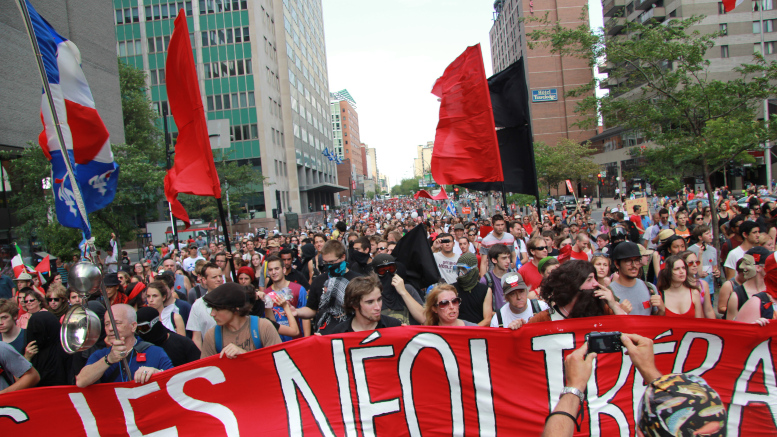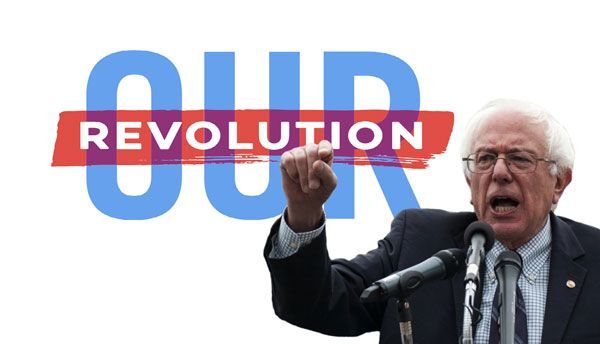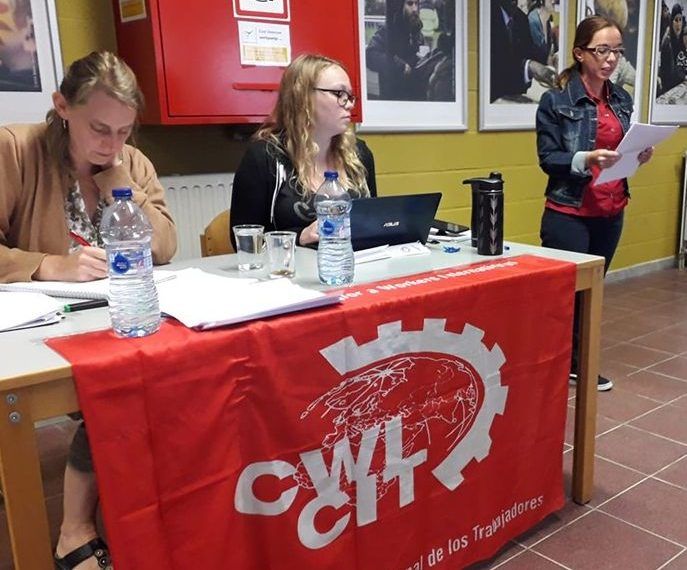Henri Saint-François and Michele Hehn are members of Alternative Socialiste (CWI in Quebec).
A socialist and trade unionist speaks about the most recent round of strikes in Quebec Editor’s note: As this interview was going to press, the Common Front leadership made a counteroffer to the Quebec government without consulting the rank and file. This has raised many questions, in particular, about the December strike days, which the membership voted for in September. How the rank-and-file responds remains to be seen, and will be covered in subsequent articles and interviews. Henri Saint-François is a member of Alternative Socialiste, as well as shop steward for the kitchen workers at a Montreal hospital with the Confédération des syndicats nationaux (National Confederation of Unions). St-Francois also works for his union during strikes. In 2014 the CSN joined other public sector unions, namely, the Fédération des travailleuses et travailleurs du Québec (Federation of Quebec Workers) and the Secrétariat intersyndicale des services publics (Inter-union Secretariat of Public Services: a grouping of smaller unions) to form the Common Front. This was to negotiate collectively the terms of their new contracts with the provincial government headed by liberal Quebec Premier Philippe Couillard. The Common Front currently represents nearly half a million workers. During this interview, Saint-François speaks about the opportunities and challenges facing the Quebecois public sector unions at this critical political moment. This interview was conducted in French and translated into English by Michele Hehn. MH: How are members of your union represented in the Common Front? HSF: Each CSN union local has a shop steward council and steering committee. The layer of organization above consists of 1) the province-wide trade federation, Fédération de la santé et services sociaux (Health and Social Services Federation); and 2) the local labour council, Conseils central du Montréal Métropolitain (Central Council of Metropolitan Montreal): the CSN sends representatives to both. The Common Front, which is the next and highest level of organization, unites almost all the public sector federations. To my understanding, the Common Front consists of representatives chosen by the steering committees of the various trade federations that make up the Common Front. MH: Martin Coiteux, President of the Treasury Council in the Couillard government, has insisted that the public sector contract negotiations end by this Christmas. This despite the fact that there is a wide gap between the salary demands of the Common Front – 4.5% increases for each of the next 5 years – and the government’s paltry 0%, 0%, 1%, 1%, 1% salary plan. The Couillard government has also recently announced that it will bail out corporate Bombardier to the tune of one billion dollars. What is the response of the Common Front to these attacks? HSF: Last year the Common Front decided to put salaries on the front burner because of 1) the huge reduction in worker purchasing power over the last 15 years, with respect to the cost of living, and 2) the growing gulf between private and public salaries for certain specialized fields. The government responded with a 2-year salary freeze, a raise in the retirement age from 60 to 62 years and crippling penalties for workers who seek to retire before 35 years of service. Because the agency that manages public sector employee retirements – Régime de retraite des employés du gouvernement et de organismes publics (Government or Public Service Employees Retirement Fund) – is fully capitalized, the union leaders were taken completely offguard by the government attacks against retirement pensions. Rather than ease its deficit by raising taxes on capital, the government has chosen to wrest it from its own pensioners: a frontal assault on labour. These are not offers – they are attacks. In addition, aside from a minuscule salary increase in the last round of collective bargaining – between 0.5% and 1% – there hasn’t been any real salary increase since 2005 while the cost of living, particularly for housing, has soared. In addition to its blows against the retirement system, the government wishes to shred what is left of employment security. We’ve already lost a lot as it is. For example, workers with more seniority have a contract that guarantees them full-time hours and sick days, whereas more recent workers like me are guaranteed only 5 days of employment every 2 weeks and are on call the rest of the time without sick days. Because of this, our hours – and pay – fluctuate greatly. As if this weren’t bad enough, the government now wants to eliminate overtime, the normal work week and incentives for those who do more stressful work, such as emergency room work or shift work. They want to remove the current 7-day notice scheduling requirement, and enable day-to-day scheduling. This opens the door to 15-hour work days, and not even necessarily in 2 consecutive shifts: you could be asked to work 7 am – 4 pm and then to return again at midnight. All of this without overtime. While the topic of salaries has generated a lot of press from both the government and the union leaderships, neither has said much about this inhumane attack on working conditions. Instead of calling for a strike vote early in the summer, so that it would go into effect in September or October, the Common Front – for whatever reason – waited until September. What has been decided is for 6 days of strikes: 3 at the regional level, and/or 3 general strikes at the provincial level. October 26-29 were the days of regional rotating strikes – the 29th was in Montreal. For November 12-19, it’s a region-wide rotation of 2 consecutive days of strikes, and then in December a 3-day, province-wide general strike. MH: How representative are the strike votes? HSF: As far as I know, all the strike votes were discussed in general assemblies. While I did hear of some places where the strike votes were poorly attended, these were the minority: in general there was very high, even record-breaking attendance. For instance, where I work, we do general assemblies in 3 different hospitals via tele-conferencing: for years we’ve struggled just to assemble a quorum of members. But for the strike discussion – which didn’t include the vote itself – the rooms were filled to bursting, with people sitting on the floor – something we’d never seen before. The actual vote, which was taken the following day was done by referendum. But during the discussion itself the shop stewards presented to the general membership various legal ways of striking and answered questions. The workers in turn did not hesitate to raise their hands with questions. While some supported a strike vote in the general assembly, and some a referendum, I voted for the latter because 1) I thought it the best way to avoid the huge logistical hurdles involved in scheduling actual physical meetings of workers with different schedules, especially hospital workers, the practical effect of which is lowered participation; and 2) we already had a generally satisfactory tradition of holding referendums. For the strike vote, about 1,600 people – almost everyone at work that day – exercised their right to vote out of a union of about 4,000 employees. Each one of these workers entered the voting booth alone and said “Yes, I want to strike for 6 days”. I find this a good way to measure opinion. MH: What are the strengths and weaknesses of the rotating strike strategy? HSF: For the past 20 years, the response of the Quebec government – whether Parti Québecois or Liberal – to public sector strikes has been to declare “special laws” that force the strikers to return to work: a hypocritical strategy that allows the government to claim that it supports the right to strike in principle, while repressing it in practice. But because of the concern about a possible special law, the leaderships decided to go for a gradual escalation, by way of testing worker willingness to turn out while minimizing the risk of a government shutdown through a special law. I found this strategy reasonable under the circumstances. In fact, worker response has been overwhelmingly positive, more than was foreseen. The workers are really willing to do more. In fact, the Common Front strategy has been exactly the same as the one adopted by the Belgian strike leaderships in the general strike of 2014. There was a big national demonstration in October, a series of regional strikes in November, and a big 1-day national general strike in December: practically a cut/paste of what is happening here. We don’t know whether this was by design, or by chance! But of course, December is much colder in Quebec, and the risk of demobilization therefore greater. MH: How much input does the rank and file have on the strategy and dates of their strikes choice of date, how to mobilize? HSF: For instance, I believe that my union local is typical in that there is a base of militants and direct, union democracy. For example, I thought our local leadership did a good job of soliciting rank-and-file input on the strike, including making a notebook available to which we could add our ideas. These ideas were filtered through the committees, and then we voted on it in the shop steward council made up of union delegates. We discussed the collective bargaining points. There is also representative democracy at the level of our federations, to which we send delegates from our locals. But as for the types of strikes actions, these were imposed by the Common Front, which was formed entirely by allying union leaderships: something that has been criticized by many. While there is solidarity in the Common Front, it exists only internally, within the orbit of federation leaders. None of this solidarity works its way down to the rank and file. As workers, we don’t control the Common Front, and often don’t know why it does what it does. That doesn’t mean that we don’t get our way sometimes! For instance, the Common Front responded to the rank and file mandate to support the May 1 “day of disturbance”. Still, just the fact that none of us – anywhere – had any say in how we were to carry out the strike raises questions. All this makes me curious to see how the Common Front will respond to the government’s offers, because if it has to go up against its own base it will be something. MH: What do you see as next steps for the Common Front? HSF: An inherent challenge in public sector strikes is that they 1) potentially affect the ability of other working class people to obtain necessary services, something the government cynically takes advantage of to make strikers appear uncaring of their fellow working class members, and 2) are susceptible to government controls. For instance, in Quebec, we healthcare workers are legally permitted only 48 minutes on strike per day: a restriction the government claims is necessary to minimize loss of patient life. Another challenge is figuring out how to maximize loss of profits while maintaining necessary health care services for the working class patients we serve. One next step is that the Common Front should challenge the government’s right to dictate strike conditions, which, however understandable, are for the workers to decide. For example, senior workers at my hospital told me that during the last strike, the feeding of patients continued as normal, while all labour to the company and visitors’ cafeteria stopped, something that caused a loss of profits and acted like an economic lever. The workers were quite capable of determining what was essential and what wasn’t. Also, the Common Front needs to widen the mobilization because 1) come December people will not be willing to freeze on picket lines, especially since they don’t get paid anyway; and 2) it is facing a majority government bent on crushing labour and well versed in pitting less paid workers against better paid unionized workers. One way to grow the struggle would be to join the campaign for $15/day, particularly with unionized workers in the private sector, such as those who work in grocery stores, who are still paid less than $15/hour. The Common Front could also call attention to the fact that even workers covered by collective bargaining can lose their jobs to budget cuts, something that is not being discussed at all. Still, it’s not as if the unions don’t know how to go on the true offensive: the problem is, they only go do it when one union raids another! What a well-oiled machine rolls out then! But when it comes time for leaderships to mobilize their base, then the message is mixed. Here’s a perfect example: the union has proposed that we not wear our uniforms while working, just as the police are doing, as a form of collective disobedience. Instead, we’re supposed to wear these t-shirts (displayed), which have the ‘Refuse Austerity” message on the back and a union message. All this is good. But here’s the hedge: 1) there aren’t enough t-shirts to go around, and no consistent information about when they’re coming in, so the workers have to wear themselves out trying to find them; 2) the t-shirt sizes are mislabelled, so that larges are smalls and smalls are large, so it’s easy in a rush to grab the wrong size; 3) the t-shirts shrink so much in the length from a cycle in the clothes drier that they look silly afterwards. Just compare this half-assed response to the well-oiled anti-raid machine! On the other hand, there is genuine anger at the base. But how far the Common Front is willing to go is an open question, particularly in the absence of any organized left opposition within the Common Front that would push for stronger action and a more democratic structure. Although the leadership of the Common Front has failed to mobilize and lead the members in a decisive way, workers see unions as the main way to fight against the government’s attacks. That’s where we are at the moment



